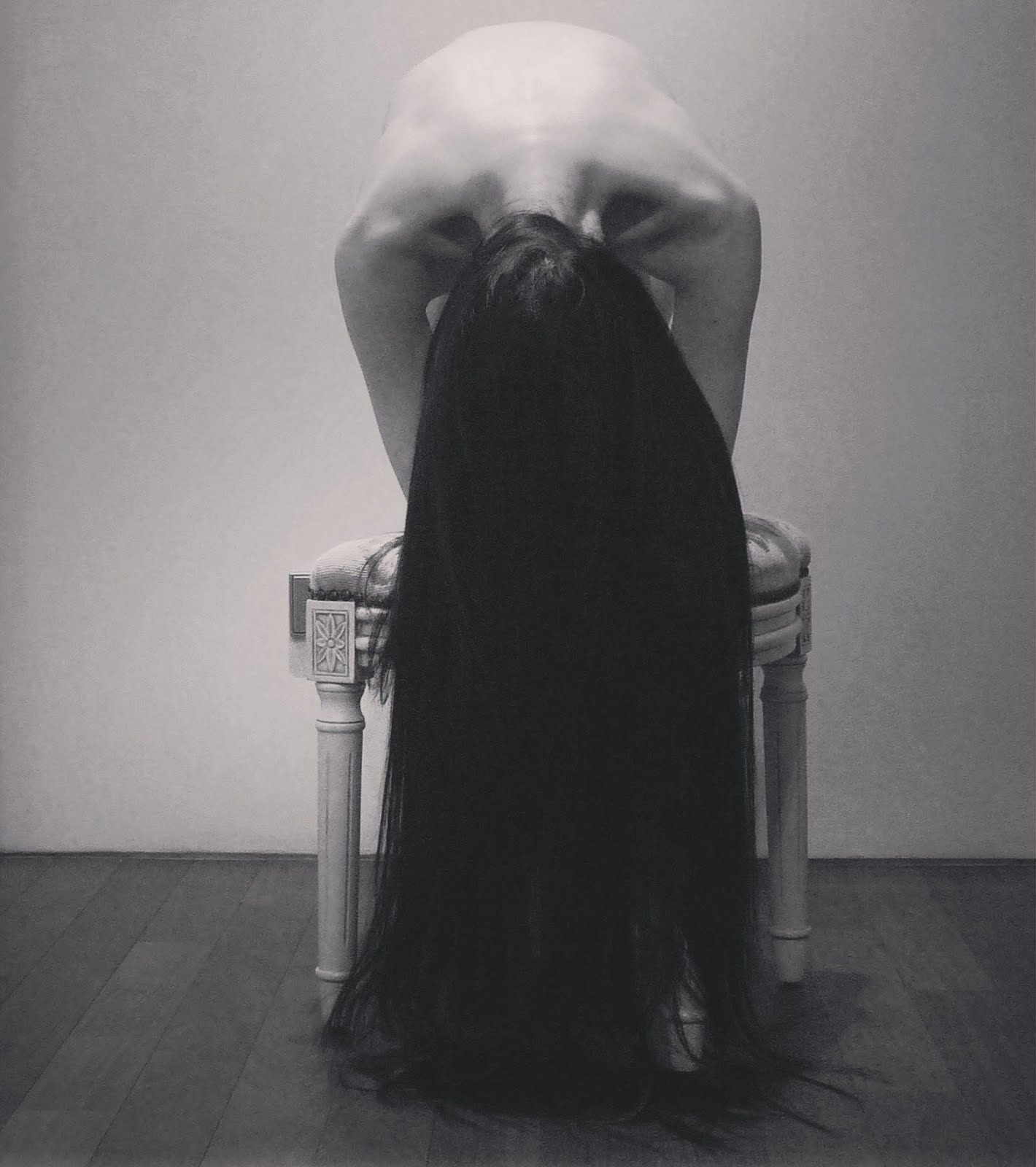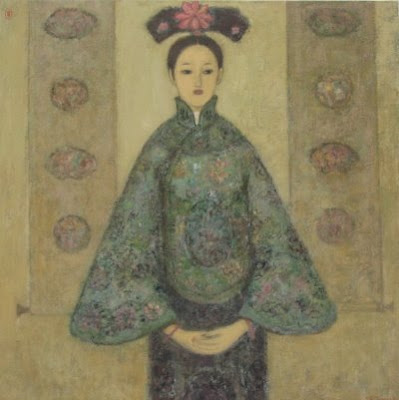Soulêve ta paupière close
Qu'effleure un songe virginal!
Je suis le spectre d'une rose
Que tu portais hier au bal.
Tu me pris encore emperlée
Des pleurs d'argent de l'arrosoir,
Et, parmi la fête étoilée,
Tu me promenas tout le soir.
Ô toi qui de ma mort fus cause,
Sans que tu puisses le chasser,
Toute la nuit mon spectre rose
À ton chevet viendra danser;
Mais ne crains rien, je ne réclame
Ni messe ni De Profundis.
Ce léger parfum est mon äme,
Et j'arrive du du paradis.
Mon destin fut digne d'envie,
Pour avoir un trépas si beau,
Plus d'un aurait donné sa vie;
Car j'ai ta gorge pour tombeau,
Et sur l'albâtre où je repose
Un poëte avec un baiser
Écrivit: "Cigît une rose,
Que tous les rois vont jalouser."

 Tamara Karsavina and Vaslav Nijinsky
Tamara Karsavina and Vaslav Nijinsky
 Nijinsky as the Rose Spirit photographed by E. O. Hoppe in 1911.
Nijinsky as the Rose Spirit photographed by E. O. Hoppe in 1911.
 Le Spectre de la Rose is amongst the most famous repertoire of the Ballets Russes. Based on a poem by Théophile Gautier and set to the music taken from Carl Maria von Weber's short piece Invitation to the Dance, it was choreographed by Michel Fokine with costume and set designs by Léon Bakst (to see more marvellous art of Léon Bakst, click here). The premiere of Le Spectre de la Rose took place on April 19, 1911 by the Ballets Russes in the Théâtre de Monte Carlo, with Vaslav Nijinsky as the Rose and Tamara Karsavina as the Girl.
Le Spectre de la Rose is amongst the most famous repertoire of the Ballets Russes. Based on a poem by Théophile Gautier and set to the music taken from Carl Maria von Weber's short piece Invitation to the Dance, it was choreographed by Michel Fokine with costume and set designs by Léon Bakst (to see more marvellous art of Léon Bakst, click here). The premiere of Le Spectre de la Rose took place on April 19, 1911 by the Ballets Russes in the Théâtre de Monte Carlo, with Vaslav Nijinsky as the Rose and Tamara Karsavina as the Girl.
Le Spectre de la Rose is such a magnificent piece and yet extremely difficult to execute well. The role of the Rose Spirit demands both technical brilliance and, more importantly in my opinion, a subtle/gentle sense of masculinity in the embodiment of a beautiful rose. In English National Ballet's celebratory performance of the Ballets Russes centenary last week, I found the dancer of the Rose Spirit to be too effeminate, albeit exhibiting near-flawless techniques.

A precious video clip of Mikhail Baryshnikov and Dame Margot Fonteyn performing Le Spectre de la Rose at the Monte Carlo Opera House in 1979. Fonteyn was 60 years of age (and still so gorgeous and extraordinary!) whilst Baryshnikov was 31.
This is my favourite version in terms of the Rose Spirit solo. I have never seen another Rose Spirit quite like Misha (unfortunately there is no surviving film footage of Nijinsky's original Le Spectre de la Rose). Just like his interpretation of Balanchine's Tchaikovsky Pas de Deux, every movement of Misha is a painting. I highly recommend this DVD where you can see the most stunning performance of Tchaikovsky Pas de Deux (and a lot more!). Misha is also my favourite Albrecht (see here, here & here). Being an unparallelled virtuoso in the classical ballet world, I love how he strove to bring out the essence of each character he danced, and at the very same time conveyed his passionate love for this art in an elegant and effortless way. I can never forget seeing him as Basil (or Basilio, the title role in Don Quixote) in American Ballet Theatre's production, dancing that infamous variation with those vertiginous grand pirouettes at the end - how beautifully he executed the piece and how infectious his big smile was. It is as though he was having the greatest time of his life! Ah the thrill of it all... Baryshnikov is truly a gem. I admire that he never ceases to reinvent himself and express his love as well as creativity in different artistic media (photography, music composition, and of course, dance).
Musically speaking, Le Spectre de La Rose is part of the song cycle Les Nuits d'Été composed by Hector Berlioz (again set to Théophile Gautier's poems). Here it is sung by Dame Janet Baker.
I fell in love with Les Sylphides after seeing English National Ballet's faithful production and interpretation last week - Diaghilev and the Ballets Russes lived again. Here is the waltz from Les Sylphides danced by Mikhail Baryshnikov and Marianna Tcherkassky (the Girl in Le Spectre de la Rose, second clip above).
Qu'effleure un songe virginal!
Je suis le spectre d'une rose
Que tu portais hier au bal.
Tu me pris encore emperlée
Des pleurs d'argent de l'arrosoir,
Et, parmi la fête étoilée,
Tu me promenas tout le soir.
Ô toi qui de ma mort fus cause,
Sans que tu puisses le chasser,
Toute la nuit mon spectre rose
À ton chevet viendra danser;
Mais ne crains rien, je ne réclame
Ni messe ni De Profundis.
Ce léger parfum est mon äme,
Et j'arrive du du paradis.
Mon destin fut digne d'envie,
Pour avoir un trépas si beau,
Plus d'un aurait donné sa vie;
Car j'ai ta gorge pour tombeau,
Et sur l'albâtre où je repose
Un poëte avec un baiser
Écrivit: "Cigît une rose,
Que tous les rois vont jalouser."

 Tamara Karsavina and Vaslav Nijinsky
Tamara Karsavina and Vaslav Nijinsky
Open your closed eyelid
Which is gently brushed by a virginal dream!
I am the ghost of the rose
That you wore last night at the ball.
You took me when I was still sprinkled with pearls
Of silvery tears from the watering-can,
And, among the sparkling festivities,
You carried me the entire night.
O you, who caused my death:
Without the power to chase it away,
You will be visited every night by my ghost,
Which will dance at your bedside.
But fear nothing; I demand
Neither Mass nor De Profundis;
This mild perfume is my soul,
And I've come from Paradise.
My destiny is worthy of envy;
And to have a fate so fine,
More than one would give his life
For on your breast I have my tomb,
And on the alabaster where I rest,
A poet with a kiss
Wrote: "Here lies a rose,
Of which all kings may be jealous."
Translation from French to English copyright © by Emily Ezust
Which is gently brushed by a virginal dream!
I am the ghost of the rose
That you wore last night at the ball.
You took me when I was still sprinkled with pearls
Of silvery tears from the watering-can,
And, among the sparkling festivities,
You carried me the entire night.
O you, who caused my death:
Without the power to chase it away,
You will be visited every night by my ghost,
Which will dance at your bedside.
But fear nothing; I demand
Neither Mass nor De Profundis;
This mild perfume is my soul,
And I've come from Paradise.
My destiny is worthy of envy;
And to have a fate so fine,
More than one would give his life
For on your breast I have my tomb,
And on the alabaster where I rest,
A poet with a kiss
Wrote: "Here lies a rose,
Of which all kings may be jealous."
Translation from French to English copyright © by Emily Ezust
 Nijinsky as the Rose Spirit photographed by E. O. Hoppe in 1911.
Nijinsky as the Rose Spirit photographed by E. O. Hoppe in 1911. Le Spectre de la Rose is amongst the most famous repertoire of the Ballets Russes. Based on a poem by Théophile Gautier and set to the music taken from Carl Maria von Weber's short piece Invitation to the Dance, it was choreographed by Michel Fokine with costume and set designs by Léon Bakst (to see more marvellous art of Léon Bakst, click here). The premiere of Le Spectre de la Rose took place on April 19, 1911 by the Ballets Russes in the Théâtre de Monte Carlo, with Vaslav Nijinsky as the Rose and Tamara Karsavina as the Girl.
Le Spectre de la Rose is amongst the most famous repertoire of the Ballets Russes. Based on a poem by Théophile Gautier and set to the music taken from Carl Maria von Weber's short piece Invitation to the Dance, it was choreographed by Michel Fokine with costume and set designs by Léon Bakst (to see more marvellous art of Léon Bakst, click here). The premiere of Le Spectre de la Rose took place on April 19, 1911 by the Ballets Russes in the Théâtre de Monte Carlo, with Vaslav Nijinsky as the Rose and Tamara Karsavina as the Girl.Le Spectre de la Rose is such a magnificent piece and yet extremely difficult to execute well. The role of the Rose Spirit demands both technical brilliance and, more importantly in my opinion, a subtle/gentle sense of masculinity in the embodiment of a beautiful rose. In English National Ballet's celebratory performance of the Ballets Russes centenary last week, I found the dancer of the Rose Spirit to be too effeminate, albeit exhibiting near-flawless techniques.

A precious video clip of Mikhail Baryshnikov and Dame Margot Fonteyn performing Le Spectre de la Rose at the Monte Carlo Opera House in 1979. Fonteyn was 60 years of age (and still so gorgeous and extraordinary!) whilst Baryshnikov was 31.
This is my favourite version in terms of the Rose Spirit solo. I have never seen another Rose Spirit quite like Misha (unfortunately there is no surviving film footage of Nijinsky's original Le Spectre de la Rose). Just like his interpretation of Balanchine's Tchaikovsky Pas de Deux, every movement of Misha is a painting. I highly recommend this DVD where you can see the most stunning performance of Tchaikovsky Pas de Deux (and a lot more!). Misha is also my favourite Albrecht (see here, here & here). Being an unparallelled virtuoso in the classical ballet world, I love how he strove to bring out the essence of each character he danced, and at the very same time conveyed his passionate love for this art in an elegant and effortless way. I can never forget seeing him as Basil (or Basilio, the title role in Don Quixote) in American Ballet Theatre's production, dancing that infamous variation with those vertiginous grand pirouettes at the end - how beautifully he executed the piece and how infectious his big smile was. It is as though he was having the greatest time of his life! Ah the thrill of it all... Baryshnikov is truly a gem. I admire that he never ceases to reinvent himself and express his love as well as creativity in different artistic media (photography, music composition, and of course, dance).
Musically speaking, Le Spectre de La Rose is part of the song cycle Les Nuits d'Été composed by Hector Berlioz (again set to Théophile Gautier's poems). Here it is sung by Dame Janet Baker.
I fell in love with Les Sylphides after seeing English National Ballet's faithful production and interpretation last week - Diaghilev and the Ballets Russes lived again. Here is the waltz from Les Sylphides danced by Mikhail Baryshnikov and Marianna Tcherkassky (the Girl in Le Spectre de la Rose, second clip above).

















































